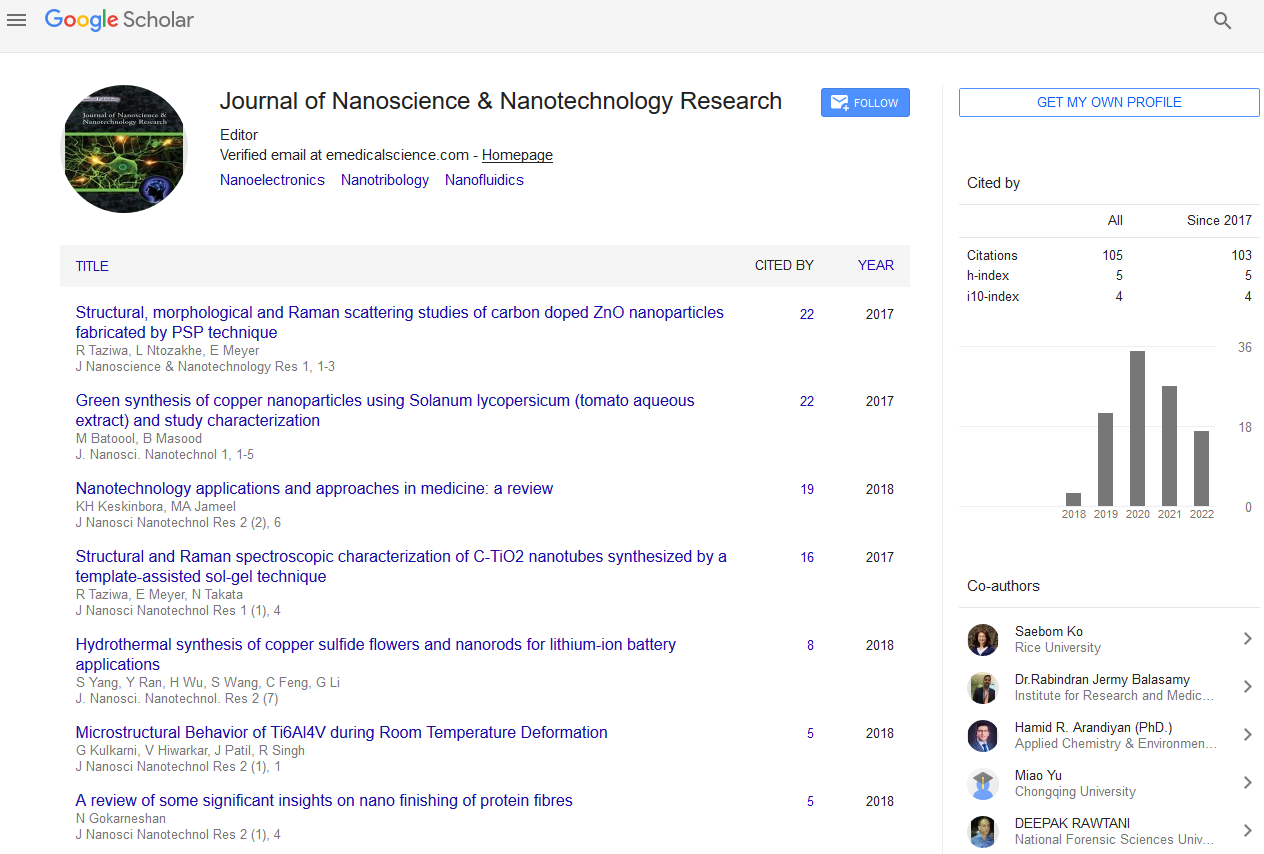Short Communication - (2024) Volume 8, Issue 2
The Critical Role of X-ray Photoelectron Spectroscopy in Modern Science and Technology
Dan Meisel*
Department of Nanoscience and Technology, Chulalongkorn University, Thailand
*Correspondence:
Dan Meisel,
Department of Nanoscience and Technology, Chulalongkorn University,
Thailand,
Email:
Received: 29-May-2024, Manuscript No. ipnnr-24-20508;
Editor assigned: 31-May-2024, Pre QC No. ipnnr-24-20508 (PQ);
Reviewed: 14-Jun-2024, QC No. ipnnr-24-20508;
Revised: 19-Jun-2024, Manuscript No. ipnnr-24-20508 (R);
Published:
26-Jun-2024, DOI: 10.12769/IPNNR.24.8.11
Introduction
X-ray Photoelectron Spectroscopy (XPS) has emerged as an
indispensable tool in the analysis of surface chemistry. As
a technique, XPS provides detailed information about the
elemental composition, chemical state, and electronic state
of the materials being analyzed. Since its development in the
1960s, XPS has become a cornerstone in materials science,
chemistry, and physics, offering insights that are critical for
advancements in various technological fields. This opinion piece
delves into the significance of XPS, its applications, and the
challenges that researchers face in maximizing its potential. At
its core, XPS operates on the principle of photoemission. When
a material is irradiated with X-rays, it emits photoelectrons. By
measuring the kinetic energy and number of these emitted
photoelectrons, scientists can deduce the binding energy of
the electrons in the material, which in turn provides a wealth
of information about the material’s surface composition and
chemistry. This surface sensitivity, typically within the top
1-10 nanometers, is particularly valuable in understanding
interactions and properties that are inherently surface-related.
Description
One of the most significant applications of XPS is in the
field of materials science. The ability to analyze the surface
chemistry of materials is crucial in the development of new
materials with tailored properties. For instance, in the field of
catalysis, XPS helps in identifying the active sites on catalyst
surfaces, thereby guiding the design of more efficient catalysts.
Similarly, in the development of advanced coatings and thin
films, XPS is used to ensure that the desired chemical states
and compositions are achieved, leading to better-performing
materials. In semiconductor technology, XPS plays a critical
role in the fabrication and quality control of semiconductor
devices. The technique is used to analyze the composition and
thickness of oxide layers, which are crucial in the performance
of semiconductor devices. As the demand for smaller and more
powerful electronic devices grows, the precision and reliability
of XPS in characterizing these materials become even more
important. XPS is also invaluable in studying chemical reactions
at surfaces and interfaces. This is particularly relevant in the
field of electrochemistry, where understanding the surface
composition of electrodes can lead to the development of
better batteries and fuel cells. By providing detailed information
about the oxidation states and chemical environments of
elements at the electrode surface, XPS helps in optimizing
the performance and longevity of electrochemical devices. In
environmental science, XPS contributes to the understanding
of how pollutants interact with surfaces. For example, in the
study of soil contamination, XPS can identify the chemical
states of heavy metals and other contaminants, providing
insights into their mobility and bioavailability. This information
is essential for developing effective remediation strategies to
clean up contaminated sites [1-5].
Conclusion
X-ray Photoelectron Spectroscopy remains a vital tool in
the scientific arsenal, driving advancements in numerous
fields by providing detailed insights into surface chemistry
and composition. As we continue to push the boundaries
of technology and material science, the role of XPS will only
become more critical. Overcoming the current challenges
through technological advancements and interdisciplinary
collaboration will ensure that XPS continues to unlock new
frontiers in science and engineering, paving the way for
innovative solutions to some of the world’s most pressing
challenges.
Acknowledgement
None.
Conflict Of Interest
None.
References
- Laura SM, Zougagh M, Valcarcel M, Rios A (2018) Analytical nanoscience and nanotechnology: Where we are and where we are heading. Molecules. 25(1):112.
[Crossref] [Google Scholar]
- Leary SP, Liu CY, Yu C, Apuzzo ML (2005) Toward the emergence of nanoneurosurgery: Part I progress in nanoscience, nanotechnology, and the comprehension of events in the mesoscale realm. Bio Man Nano. 18:161-185.
[Crossref] [Google Scholar]
- Rasmussen AJ, Ebbesen M (2014) Why should nanoscience students be taught to be ethically competent? Drug Deliv Trans Res. 10 (1):216-226.
[Crossref] [Google Scholar]
- Kurath M, Maasen S (2006) Toxicology as a nanoscience? Disciplinary identities reconsidered. Life Sci. 216:183-188.
[Crossref] [Google Scholar]
- Avery T (2019) Nanoscience and literature: Bridging the two cultures. Mater Sci Eng C. 97:397-405.
[Crossref] [Google Scholar]
Citation: Meisel D (2024) The Critical Role of X-ray Photoelectron Spectroscopy in Modern Science and Technology. J Nanosci Nanotechnol Res. 08:11.
Copyright: © 2024 Meisel D. This is an open-access article distributed under the terms of the Creative Commons Attribution License, which permits unrestricted use, distribution, and reproduction in any medium, provided the original author and source are credited.

